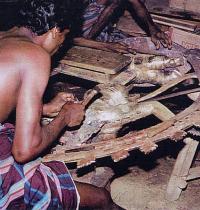Sharada Srinivasan
Grant Period: Over two years
Historians and archaeologists agree that the study of metal crafts assists us greatly in evaluating the longevity of human civilisations. Today though, metal crafts are in danger of being rendered irrelevant in the face of technological progress. India's rich metal craft techniques continue to be counted as elements of a ‘living’, albeit fragile, tradition, despite all too apparent threats to its future. It is this fraught context that Dr Sharada Srinivasan’s research will seek to address.
Dr Srinivasan has wide experience in the interdisciplinary field of archaeometallurgy. This under-researched discipline in Indian academics is concerned with the scientific investigation of metal artefacts that helps build our understanding of antiquity. On examining current studies in this field, Dr Srinivasan finds that these fall into either one of two categories: scientific reports that detail the technical processes of metal crafts, but ignore larger socio-historical contexts, on the one hand, and ethnographic surveys that provide descriptions of societies that extensively use metal artefacts, but offer very little technical insights into the craft and its techniques, on the other.
Dr Srinivasan’s IFA-supported project is directed at filling significant gaps in existing documentation in this area and integrating distinct perspectives in archaeometallurgy. Trained at the Indian Institute of Technology (IIT), Mumbai, Dr Srinivasan is equipped to study metals technology processes. However, she has increasingly felt the need to substantiate her scientific research on metal crafts traditions with an understanding of the larger social and historical contexts within which these traditions are located. Her current project will enable her to form a sense of the interface between technological processes, and culture and the arts in societies that extensively produced metal artefacts. Evaluators of Dr Srinivasan’s proposal noted this unusual attention of a technologist to performance arts, ritual arts, martial arts and ceremonial arts traditions. Using an interpretative framework, she will seek to establish links between technological aspects of metal crafts and its wider cultural significance. Her research would contribute to our understanding of the manner in which “artistic, ritual, performance and philosophical impulses shape technological products.”
During her project term, Dr Srinivasan will examine archaeological records, literary and epigraphic sources and ethnographic studies in order to generate a comprehensive documentation of traditional metalworking and craft practices. This ‘techno-cultural perspective’ will help generate a view of “metal artefacts not so much as art objects but as ‘movement arts’.” While a book-length manuscript provisionally titled India’s Metals Heritage: Assaying Technology through Art and Movement Arts will be the primary outcome of this project, Dr Srinivasan is also excited by the possibility of developing a photographic exhibition, and writing the script for a documentary film on little known aspects of lndia’s metal crafts heritage.

